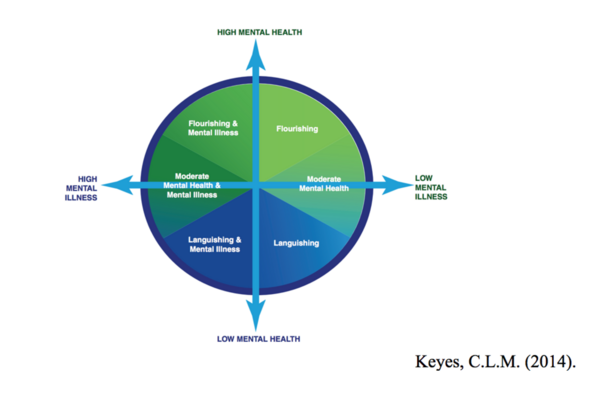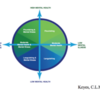What does “mental health” mean to you? Is this different from “mental illness”?
Some people also use the terms “mental flourishing”, “mental languishing”, “mental wellness”, and the list goes on. One step Extension professionals can use to reduce stigma and put the mental health conversation on the table is to clear up our understanding of terms.
First, let’s consider “mental health”. This may make you think about depression, anxiety, or other common mental health struggles. Often when we hear “mental health,” we think “mental illness”. The two terms are sometimes used interchangeably, or they’re considered opposites of one another like two ends of the same spectrum.
But a person can function well even when they have a diagnosis. And they can struggle without a diagnosis. A clear way to think about the changing states of mental health and mental illness is to consider two dimensions as described by Dr. Corey Keyes in the Dual Continuum Model of Mental Health1. See attached model.
 This model suggests that mental health and mental illness are not opposites on the same spectrum, but rather related and interacting states. In this model, a person can experience anywhere from serious mental illness (the left-hand side), to no mental illness (the right-hand side). And at the same time, that same person can also experience anywhere from poor mental health functioning (the bottom) to optimal mental health functioning (the top).
This model suggests that mental health and mental illness are not opposites on the same spectrum, but rather related and interacting states. In this model, a person can experience anywhere from serious mental illness (the left-hand side), to no mental illness (the right-hand side). And at the same time, that same person can also experience anywhere from poor mental health functioning (the bottom) to optimal mental health functioning (the top).
Our mental health is continually affected by many different factors in our lives - our relationships, our experiences, and our access to the basic needs of life. Our state of mental health can change as these situations change.
A person is considered to be “flourishing” if they fall in the top half of this model. “Flourishing” means that you are functioning well mentally. A diagnosis may or may not be present. And a person is considered to be “languishing” if they fall into the bottom half. Again, a diagnosis may or may not be present. Languishing can be described as emptiness, or stagnation.
If we consider “Mental Flourishing” more specifically, it means that you are functioning well in 3 main areas – emotionally, psychologically and socially.2
- Emotionally is about how you feel. For example, are you generally happy, and satisfied with your life?
- Psychologically is about how you function as an individual. For example, do you have a sense of purpose and direction in your life?
- Socially is about how you function in society. For example, do you feel you belong and contribute to a larger community?
Because Mental Flourishing includes all these areas of functioning, there are many things we can do to promote mental health, in addition to treating illness. For example, we can:
- become aware of our emotions
- practice calming activities such as mindful breathing or meditation
- build caring relationships with other people
- build community so that people feel connected with one another
- ensure that basic needs of food, shelter, access to healthcare, etc. are met
- engage in civic activities
- support the foundational building blocks of good nutrition, exercise and sleep
- spend time in nature (for example, taking a walk, visiting state parks).
The World Health Organization defines mental health as: “a state of mental well-being that enables people to cope with the stresses of life, realize their abilities, learn well and work well and contribute to their community.”
So, there is a lot more to experiencing “mental health” than not being mentally ill. We all have a role to play – so let’s start the conversation!
References:
- Keyes, C.L.M. (2014). Mental Health as a Complete State: How the Salutogenic Perspective Completes the Picture. In: Bauer GF, Hämmig O, editors. Bridging Occupational, Organizational and Public Health: A Transdisciplinary Approach. London: Springer; 2014. p. 179–92)
- Lamers, S. M. A., Westerhof, G. J., Bohlmeijer, E. T., ten Klooster, P. M., & Keyes, C. L. M. (2011). Evaluating the psychometric properties of the mental health Continuum-Short Form (MHC-SF). Journal of Clinical Psychology, 67(1), 99-110. doi: https://doi.org/10.1002/jclp.20741]
- World Health Organization 2006. Constitution of the World Health Organization - Basic Documents. Forty-fifth edition, Supplement, October, 2006.

Comments (0)